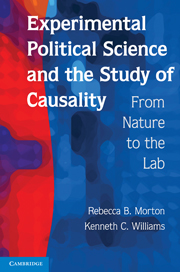15 - Appendix: The Experimentalist's To Do List
Published online by Cambridge University Press: 05 June 2012
Summary
Throughout this book we have attempted both to describe the methodology of experimental political science and to give advice to new experimentalists. In this appendix we provide an experimentalist's to do list that summarizes what an experimentalist needs to consider in designing and conducting an experiment as well as in analyzing experimental data. We reference parts of the book that are relevant for each item. Note that, although the items are numbered, they should not be viewed as chronological; that is, a researcher may address how he or she plans to evaluate a causal relationship before figuring out the specific target population for the experiment.
The Target Population and Subject Pools
An experimentalist should identify the target population for the study and how that target population relates to the subjects recruited for the experiment (see Definition 2.2).
Nonspecific Target Populations
If the target population is “humanity,” as discussed in Chapter 9, then the experimentalist can reasonably use any subject pool for a first investigation of a particular experimental design. In such a case, the target population for the experiment becomes the subject pool from which the subjects are drawn and the results are valid for that pool (assuming that the subjects are randomly drawn from that pool). The subject pool is defined as the set of recruited subjects who are willing to participate.
- Type
- Chapter
- Information
- Experimental Political Science and the Study of CausalityFrom Nature to the Lab, pp. 530 - 538Publisher: Cambridge University PressPrint publication year: 2010



